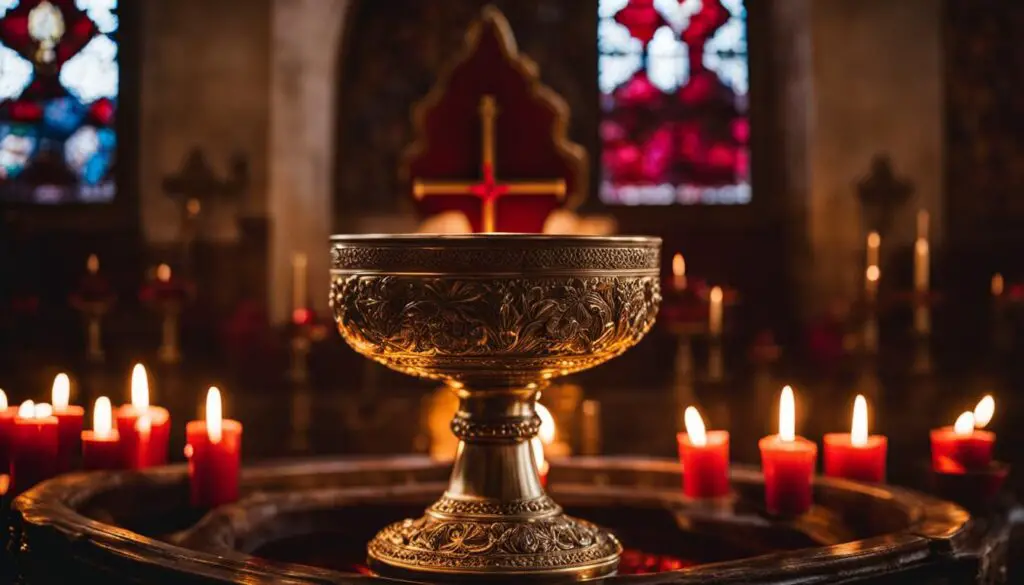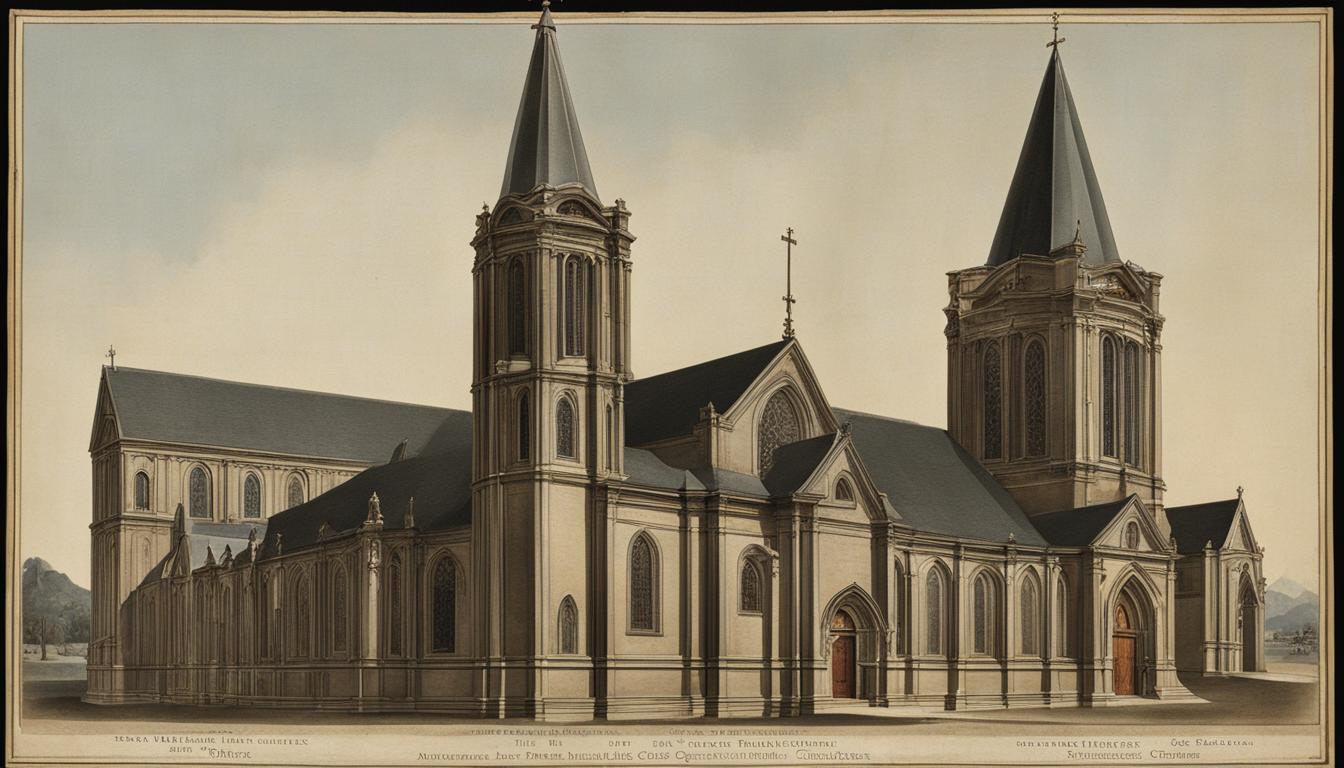Welcome to our exploration of Peter’s Confession and its significance in the Christian faith. Matthew 16:18 holds a pivotal moment in the Bible where Jesus addresses Peter, proclaiming, “You are Peter, and on this rock, I will build my church.” This powerful statement has sparked endless discussions and debates about Peter’s role, the foundation of the church, and the interpretation of this profound passage.
Throughout history, Peter’s Confession has influenced the beliefs, practices, and traditions of the Christian community. From its historical origins to the diverse denominations and sects within Christianity, this confession holds immense importance for believers worldwide. It shapes the understanding of the church’s foundation, the role of leadership and clergy, the sacraments and rituals, worship practices, and so much more. Let’s embark on this journey together and explore the various aspects of Peter’s Confession.
Key Takeaways:
- Peter’s Confession, as recorded in Matthew 16:18, is a significant moment in the Christian faith.
- The confession forms the foundation of the church and shapes beliefs, practices, and traditions.
- It is connected to the role of Peter as the first pope and the establishment of apostolic succession.
- Sacraments, rituals, worship practices, and leadership in the church are influenced by Peter’s Confession.
- The confession continues to inspire and guide the Christian community today.
The Historical and Origins of Peter’s Confession
The historical origins of Peter’s Confession can be traced back to the New Testament. This pivotal moment occurs in the context of a conversation between Jesus and his disciples. Jesus poses a question to his disciples, asking them who they believe he is.
In response, Peter boldly declares that Jesus is the Messiah and the Son of God. This profound confession by Peter serves as the foundation for his role within the early Christian community and lays the groundwork for the establishment of the church.
This historical account of Peter’s Confession not only highlights Peter’s unwavering faith but also underscores the significance of acknowledging Jesus as the Son of God. It signifies a turning point in the disciples’ understanding of Jesus’ true identity and paves the way for the spread of Christianity.

Through Peter’s Confession, a profound truth is revealed – Jesus is not just a teacher or prophet, but the long-awaited Messiah who has come to fulfill the promises of the Old Testament. This confession becomes a cornerstone of the Christian faith, emphasizing the importance of recognizing Jesus’ divinity and surrendering to Him as the ultimate source of salvation.
Beliefs and Doctrines Based on Peter’s Confession
Peter’s Confession serves as a foundational belief for many Christian denominations, shaping various beliefs and doctrines within Christianity. This pivotal moment in affirming Jesus as the Messiah and the Son of God forms the bedrock of the Christian faith.
“You are Peter, and on this rock I will build my church.”
– Matthew 16:18
The belief in Peter’s Confession as the rock upon which Jesus will build his church symbolizes the understanding that Jesus is the foundation of the Christian faith. This confession not only solidifies Jesus as the Messiah, but it also highlights the significance of Peter’s role in the early Christian community.
Doctrines:
Based on Peter’s Confession, several doctrines have emerged within Christianity, including:
- The primacy of Peter: Some Christian traditions interpret Peter’s Confession as an indication of his leadership and authority within the church. This belief forms the basis for the papacy and apostolic succession in certain denominations.
- The divinity of Jesus: Peter’s Confession unequivocally affirms Jesus as the Son of God and the Messiah. This belief is central to the Christian faith and influences theological understandings of the nature and identity of Jesus.
- The authority of Scripture: Peter’s Confession, recorded in the Bible, reinforces the sacredness and authority of Scripture within Christianity. The teachings and stories found in the Bible guide the beliefs and practices of the church.
- The role of confession: Peter’s acknowledgment of Jesus as the Messiah encourages believers to confess their faith in Jesus Christ. Confession of faith is seen as a vital aspect of Christian discipleship and the expression of one’s relationship with Jesus.
Peter’s Confession continues to shape the beliefs, practices, and traditions of the Christian community. It serves as a reminder of the importance of faith in Jesus Christ as the foundation of the church and the source of salvation.

The Sacraments and Rituals of the Church
The sacraments and rituals hold profound significance within the Christian faith, serving as sacred practices that allow believers to express and deepen their relationship with Jesus Christ. These sacraments and rituals are intimately connected to Peter’s Confession and play pivotal roles in the life of the church.
Baptism: One of the fundamental sacraments of the church, Baptism symbolizes the spiritual cleansing and rebirth of an individual into the Christian community. Through the symbolic act of immersion or sprinkling with water, baptism represents the forgiveness of sins and the initiation into the body of Christ, the church. It signifies a personal commitment to follow Jesus and embrace a life of faith.
The Eucharist: Also known as the Holy Communion or the Lord’s Supper, the Eucharist is a ritual that commemorates and reenacts Jesus’ Last Supper with his disciples. In this sacrament, believers partake in bread and wine, which symbolize the body and blood of Jesus Christ. The Eucharist represents the spiritual nourishment and unity of the church, as believers come together to remember Jesus’ sacrifice, express their gratitude, and renew their commitment to follow him.
“Through the sacraments and rituals, the church channels the spiritual significance of Peter’s Confession, providing believers with tangible experiences of God’s grace and presence.”
These sacraments and rituals hold immense spiritual significance for believers. They serve as visible signs of God’s grace and love, strengthening the faith of individuals and fostering a sense of unity and community within the church.
Additionally, the church observes various rituals and practices throughout the liturgical year, such as the sacraments of Confirmation, Reconciliation (also known as Confession or Penance), Anointing of the Sick, and Holy Orders. Each of these rituals carries profound meaning and contributes to the spiritual journey and growth of believers.
The sacraments and rituals of the church provide believers with tangible experiences of God’s grace and presence. They not only deepen individual faith but also foster a collective identity and sense of belonging within the Christian community. Through these sacred practices, believers are reminded of Peter’s Confession and the foundational role it plays in their lives and in the life of the church.

| Sacraments | Description |
|---|---|
| Baptism | Symbolizes spiritual cleansing, initiation into the Christian community |
| Eucharist | Communion, remembrance of Jesus’ sacrifice, spiritual nourishment |
| Confirmation | Sealing and strengthening of faith through the Holy Spirit |
| Reconciliation | Confession and forgiveness of sins |
| Anointing of the Sick | Prayer and anointing for healing and comfort |
| Holy Orders | Ordination of individuals into the clergy |
Leadership and Clergy in the Church
The church is not only a spiritual home for its members but also a community guided by dedicated leaders and clergy. The leadership and clergy play a crucial role in shepherding and nurturing the congregation, providing guidance and support in their spiritual journeys.
One significant connection to Peter’s Confession is the role of Peter as the first pope, which established a model of leadership in certain Christian traditions. The concept of apostolic succession, the passing of authority from the apostles to their successors, also carries the legacy of Peter’s Confession and the foundation of the church.
The leadership and clergy are entrusted with upholding the teachings and traditions of the church, ensuring that the faithful learn and grow in their faith. They serve as spiritual mentors, offering pastoral care, guidance, and counseling to individuals and families within the community.
Through their dedication and commitment, the clergy provide a strong foundation for the church, inspiring others to live out their faith and fostering a sense of unity and purpose. They lead by example, encouraging the congregation to embrace the teachings of Jesus Christ and serve as ambassadors of faith in the wider community.
“The work of the clergy is not just a profession; it is a calling, a vocation to serve God and His people. They bear the immense responsibility of shepherding the flock, providing spiritual guidance, and leading by example.”
As leaders within the church, clergy often hold key positions in decision-making processes, ensuring the church’s mission and values are upheld. They oversee the administration of sacraments, perform religious ceremonies, and lead worship services that allow the congregation to come together in prayer and worship.
The role of leadership and clergy extends beyond the walls of the church, as they strive to be a positive influence in the broader community. They often engage in outreach programs, serving the marginalized, advocating for social justice, and spreading the message of love and compassion.

The leadership and clergy are the backbone of the church, providing spiritual guidance, fostering a sense of community, and exemplifying the teachings of Jesus Christ. Through their dedicated service and commitment, they ensure the church remains a beacon of faith and hope in a world that is in constant need of divine guidance.
Worship Practices and Traditions
Worship practices and traditions are fundamental aspects of the Christian faith and are embraced by various denominations. These practices serve as a way for believers to express their devotion, gratitude, and reverence to God. Rooted in the foundation of Peter’s Confession, worship in the church takes many forms, each carrying deep spiritual significance.
Liturgical Worship
Liturgical worship is a common practice in many Christian churches. It follows a structured order of service that includes prayers, Scripture readings, hymns, and sacraments. Liturgical worship seeks to create a sacred space where worshippers can encounter God and participate in the traditions passed down through generations.
Hymns and Psalms
Music has always played a vital role in Christian worship. Hymns and psalms allow worshippers to offer praise, find solace, and connect with the divine. These poetic expressions of faith often carry rich theological teachings, encapsulating the beliefs and values of the church.
Prayer
Prayer is a fundamental practice in Christianity, allowing believers to communicate with God, seek guidance, and offer thanksgiving. It can be both personal and communal, taking the form of spontaneous prayers or reciting traditional prayers passed down through generations.
Sacraments and Rituals
Central to worship in many Christian traditions are the sacraments and rituals. These sacred acts, such as baptism and the Eucharist, hold deep spiritual significance and represent an intimate connection with Christ and his redemptive work. Through these sacraments, believers participate in the life of the church and experience God’s grace and presence.
The sacraments are like channels through which God pours out his blessings upon his people. They are visible signs that point to the invisible reality of God’s love and grace.
Celebrations and Seasons
The Christian calendar is filled with celebrations and seasons that mark significant events in the life of Christ and the church. Advent, Christmas, Lent, Holy Week, Easter, and Pentecost are just a few examples. These observances serve as a reminder of the faith journey and provide opportunities for reflection, repentance, and renewal.
Fellowship and Communal Worship
Christian worship is not limited to the individual but extends to the communal. Gathering together as a church community allows believers to offer support, encouragement, and accountability to one another on their spiritual journey. Communal worship strengthens the bonds of fellowship and creates an atmosphere where believers can experience the presence of God collectively.
| Worship Practices | Denominations |
|---|---|
| Liturgical Worship | Roman Catholic, Eastern Orthodox, Anglican |
| Hymns and Psalms | Protestant, Pentecostal, Baptist |
| Prayer | All Christian Denominations |
| Sacraments and Rituals | Lutheran, Catholic, Orthodox |
| Celebrations and Seasons | All Christian Denominations |
| Fellowship and Communal Worship | All Christian Denominations |
Sacred Texts in Christianity
Sacred texts have always held a central position in Christianity, providing believers with a roadmap of faith and principles to guide their lives. The most revered and widely recognized sacred text is the Bible.
The Bible is regarded as the inspired Word of God and is cherished for its teachings, stories, and wisdom. It contains the Old Testament, which includes ancient Hebrew scriptures, and the New Testament, which recounts the life, teachings, and works of Jesus Christ and the early Christian community.
The Bible is a sacred text that serves as a divine revelation, offering spiritual guidance, moral compass, and a source of inspiration for millions of Christians worldwide.
Within the Bible, various passages and narratives are intricately linked to Peter’s Confession and hold significant theological significance. These texts provide profound insights into the beliefs and practices of the Christian faith.
Key Texts Related to Peter’s Confession:
- Matthew 16:18: This verse is the cornerstone of Peter’s Confession. It records Jesus affirming Peter’s faith and declaring him as the rock upon which He will build His church.
- Acts 2:14-41: In this passage, Peter delivers a powerful sermon on the day of Pentecost, proclaiming Jesus as the resurrected Messiah and calling the people to repentance.
- Acts 10:9-48: Peter’s encounter with Cornelius, a Gentile, challenges his understanding of God’s inclusivity and marks a pivotal moment in the early Christian community’s acceptance of Gentile believers.
These texts, along with many others, are studied, meditated upon, and interpreted by Christians, providing them with a deep understanding of their faith and serving as a guide for their moral, ethical, and spiritual journey.

| Sacred Text | Significance |
|---|---|
| Old Testament | Contains the foundational scriptures of Judaism, which are also considered sacred by Christians. It provides historical context and prophecies related to the coming of the Messiah. |
| New Testament | Focuses on the life, teachings, death, and resurrection of Jesus Christ. It includes the Gospels, Epistles, and the Book of Revelation, providing a comprehensive account of Christian beliefs and practices. |
Denominations and Sects within Christianity
Christianity is a diverse religion with a rich tapestry of denominations and sects that reflect varying interpretations of scripture and theological perspectives. These different groups within the Christian faith have developed unique beliefs, practices, and organizational structures that shape their communities and worship. While all Christians share a common foundation in the teachings of Jesus Christ and Peter’s Confession, the differences among denominations and sects add depth and diversity to the broader Christian tradition.
Denominations
Denominations in Christianity are larger religious organizations composed of multiple local churches that share common beliefs, practices, and doctrinal traditions. These denominations often have established structures and hierarchies and can be categorized into major branches of Christianity, such as Catholicism, Protestantism, and Eastern Orthodoxy. Each major branch comprises multiple denominations, including:
- Roman Catholic Church
- Anglican Communion
- Lutheran Church
- Methodist Church
- Pentecostal Church
- Baptist Church
- Presbyterian Church
These denominations may differ in their interpretations of scripture, sacraments, worship practices, and governance structures, but they all share a common commitment to following Jesus Christ and spreading His message of love and salvation.
Sects
Sects within Christianity are smaller religious groups that separate from established denominations due to differences in interpretation, theology, or social and cultural practices. These sects tend to have a more distinct identity and often emphasize specific theological beliefs or spiritual practices. Some well-known sects within Christianity include:
- Mormonism (Latter-Day Saints)
- Jehovah’s Witnesses
- Quakers (Society of Friends)
- Amish
- Christian Science
These sects often have their own unique doctrines, rituals, and organizational structures that distinguish them from mainstream denominations. While they may share certain core beliefs with other Christians, their distinctiveness adds to the rich tapestry of Christian faith expressions.
Unity Amidst Diversity
Despite the differences among denominations and sects, there is an underlying unity that all Christians share through their faith in Jesus Christ. The diversity within Christianity reflects the beauty of human interpretation and the multifaceted nature of religious experience. It is a testament to the ongoing exploration of faith and the vibrant spiritual journeys of individuals and communities. In the midst of this diversity, Christians continue to seek a common understanding of Peter’s Confession and the teachings of Jesus Christ, striving for unity, love, and fellowship within the broader Christian community.
Community and Outreach in the Church
Community and outreach are fundamental aspects of the Christian faith, reflecting the teachings of Peter’s Confession. Christians are called to come together as a community of believers, supporting and encouraging one another in their spiritual journeys. This sense of community extends beyond the walls of the church, as believers aim to reach out to the world and share the transformative message of Jesus Christ through various outreach efforts.
One of the key ways the church engages in outreach is through evangelism, the sharing of the Gospel with those who have not yet encountered the love and salvation of Christ. This can take many forms, from personal conversations and Bible studies to organized events and mission trips. By reaching out to others with compassion and love, Christians hope to inspire faith and bring others into the community of believers.
Additionally, community outreach involves active participation in social justice initiatives. The church recognizes the call to seek justice and be a voice for the marginalized and oppressed, mirroring the teachings of Jesus Christ. Through initiatives such as feeding the hungry, providing shelter to the homeless, and advocating for equal rights, the church seeks to make a positive and tangible impact in the world.
“Truly I tell you, whatever you did for one of the least of these brothers and sisters of mine, you did for me.”
– Jesus Christ (Matthew 25:40)
The image below depicts a diverse group of people coming together in unity, representing the inclusive and welcoming nature of the church community.
Through community and outreach efforts, the church aims to embody the teachings of love, compassion, and inclusivity that were exemplified by Jesus Christ. By extending care and support to those in need and sharing the transformative message of the Gospel, the church seeks to bring about positive change and create an environment of hope and healing.
Architectural and Artistic Features in Churches
Churches are not only places of worship but also showcases of stunning architectural and artistic craftsmanship. These sacred spaces often feature a myriad of elements that reflect the beliefs and traditions of the Christian faith. From soaring spires to intricate stained glass windows, each feature tells a unique story and invites visitors to contemplate the beauty and symbolism behind them.
One of the most iconic architectural features in churches is the stained glass window. These vibrant works of art depict scenes from biblical stories, saints, and significant events in the history of Christianity. The play of light through these colorful panes creates a mesmerizing effect, evoking a sense of divine presence and awe.
Another remarkable feature commonly found in churches is sculptures. Intricately carved statues of saints, biblical figures, and angels adorn the interiors and exteriors of these sacred spaces. Each sculpture is a testament to the skill and devotion of the artists, as well as a visual representation of the spiritual beings they represent.
Paintings also play a significant role in the artistic presentation of churches. From large-scale murals covering walls and ceilings to smaller framed artworks, these paintings depict biblical narratives, religious symbols, and portraits of saints. They add depth and visual richness to the worship environment, immersing individuals in the stories and teachings of the Christian faith.
“The architectural and artistic features in churches serve as visual expressions of the beliefs and traditions of the Christian community, inviting worshippers to contemplate the divine and deepen their spiritual connection.”
Examples of Architectural and Artistic Features in Churches
| Feature | Description | Symbolism |
|---|---|---|
| Stained Glass Windows | Colorful glass panels depicting biblical scenes and religious figures. | Divine illumination and inspiration. |
| Sculptures | Intricately carved statues of saints, angels, and biblical characters. | Representation of the divine and spiritual beings. |
| Paintings | Large-scale murals and framed artworks illustrating biblical narratives and religious symbols. | Visual storytelling and representation of faith. |
These architectural and artistic features create a sacred atmosphere within churches and enhance the worship experience. They serve as visual expressions of the beliefs and traditions of the Christian community, inviting worshippers to contemplate the divine and deepen their spiritual connection.
Contemporary Issues and Challenges in the Church
In today’s modern world, the church, like any other institution, grapples with various contemporary issues and challenges. These can range from theological debates to social and ethical concerns, as well as navigating the ever-changing cultural landscape. It is crucial for the church to stay rooted in its foundation, particularly in Peter’s Confession, to find insights and guidance in addressing these challenges.
Debates over Theological Interpretations
One of the ongoing challenges in the church revolves around theological interpretations. Different perspectives and interpretations can lead to debates and divisions within the Christian community. It is vital for the church to foster an environment of respectful dialogue and open-mindedness, embracing diverse theological viewpoints while maintaining a focus on the core beliefs and teachings of Peter’s Confession.
Social and Ethical Issues
The church faces numerous social and ethical issues that require careful consideration and compassionate response. Topics such as human rights, social justice, environmental stewardship, and ethical dilemmas challenge the church to apply the teachings of love, compassion, and justice found in Peter’s Confession to the complex issues of our time.
“The church must proactively engage with contemporary social and ethical issues, offering a compassionate and Christ-centered perspective, while acknowledging the complexities of the world we live in.”
Adapting to the Changing Cultural Landscape
The cultural landscape is continually evolving, presenting both opportunities and challenges for the church. Adapting to societal changes without compromising the foundational beliefs of Peter’s Confession is a delicate balance. The church must navigate cultural shifts while remaining steadfast in upholding the essence of the Christian faith, effectively bridging the timeless teachings of Jesus with the ever-changing needs and aspirations of society.
Embracing Technology and Digital Transformation
In the digital age, rapid advancements in technology shape the way people communicate, interact, and seek spiritual resources. The church faces the challenge of embracing technology without losing the essence of personal connection and community. Leveraging technology can enable the dissemination of scriptural teachings, facilitate online worship experiences, and expand outreach efforts to engage with a wider audience.
Conclusion
Peter’s Confession, as recorded in Matthew 16:18, is a pivotal moment in the history and foundation of the Christian faith. This profound declaration by Peter affirms his belief in Jesus as the Messiah and the Son of God, solidifying his role within the early Christian community. Peter’s Confession has had a lasting impact on the beliefs, practices, and traditions of the Christian community throughout the centuries.
At its core, Peter’s Confession emphasizes the significance of faith in Jesus and his divine nature. It serves as a reminder to all believers of the fundamental truth upon which the Christian faith is built. The confession of Peter echoes the words of Jesus, who declares that the church will be built on this foundation, establishing the community of believers that would spread the message of salvation.
The implications of Peter’s Confession extend beyond its historical context. It continues to inspire and guide the Christian community today. The confession serves as a foundation of faith, reminding believers to place their trust in Jesus as the Messiah and the Son of God. It also encourages believers to emulate Peter’s boldness and unwavering commitment to the truth, even in the face of opposition and challenges.
Throughout history, Peter’s Confession has shaped various aspects of the Christian faith. It has influenced beliefs and doctrines, sacraments and rituals, leadership and clergy, worship practices, and the interpretation of sacred texts. Additionally, it has played a role in the development of different denominations and sects within Christianity. The confession’s impact extends to the emphasis on community and outreach, the reverence for architectural and artistic features in churches, and the navigation of contemporary issues and challenges.
FAQ
What is Peter’s Confession in the Bible?
Peter’s Confession refers to the moment in the New Testament where Peter declares that Jesus is the Messiah, the Son of God. It is recorded in Matthew 16:18 and is seen as a pivotal moment in affirming Jesus as the foundation of the church.
What role does Peter’s Confession play in Christianity?
Peter’s Confession forms the basis of the Christian faith and is a foundational belief for many Christian denominations. It is seen as a declaration of Jesus as the Messiah and the Son of God, serving as the bedrock of the church’s teachings and traditions.
How are the sacraments and rituals of the church connected to Peter’s Confession?
The sacraments and rituals of the church, such as baptism and the Eucharist, are often associated with Peter’s Confession. They serve as ways for believers to express and strengthen their faith in Jesus Christ, who is the foundation of the church.
What is the role of leadership and clergy in the church based on Peter’s Confession?
Peter’s Confession is sometimes connected to the role of Peter as the first pope and the establishment of apostolic succession within certain Christian traditions. The leadership and clergy are responsible for upholding the teachings and traditions of the church, guiding and shepherding the congregation.
How do worship practices and traditions relate to Peter’s Confession?
The worship practices and traditions of the church, including liturgical worship, hymns, prayers, and other forms of worship, are all expressions of one’s faith in Jesus Christ and the acknowledgment of his role as the foundation of the church, as affirmed in Peter’s Confession.
What is the significance of sacred texts in Christianity, particularly in relation to Peter’s Confession?
Sacred texts, such as the Bible, play a central role in Christianity. The teachings and stories found within these texts are often connected to Peter’s Confession and serve as a guide for the beliefs and practices of the church. The Bible is seen as the inspired Word of God and provides spiritual guidance and understanding.
How do different Christian denominations interpret Peter’s Confession?
Different Christian denominations and sects have their own interpretations and understandings of Peter’s Confession and the teachings of Jesus Christ. The differences in beliefs and practices among denominations are often a result of varying interpretations of Scripture and theological perspectives.
What is the importance of community and outreach in the church, considering Peter’s Confession?
Based on Peter’s Confession, Christians are called to be a community of believers who support and encourage one another. Outreach efforts, such as evangelism and social justice initiatives, are ways in which the church reaches out to the world and shares the message of Jesus Christ, as exemplified in Peter’s Confession.
How do architectural and artistic features in churches reflect Peter’s Confession?
Churches often feature unique architectural and artistic elements that reflect the beliefs and traditions of the Christian faith. These features can include stained glass windows, sculptures, paintings, and intricate designs. Depicting Peter’s Confession in these artistic representations celebrates and commemorates this important moment in Christian history.
How does Peter’s Confession guide the church in addressing contemporary issues and challenges?
The church, like any other institution, faces contemporary issues and challenges in the modern world. Understanding the foundation of the church in Peter’s Confession provides insights and guidance in navigating these challenges, including debates over theological interpretations, social and ethical issues, and the changing cultural landscape.
















